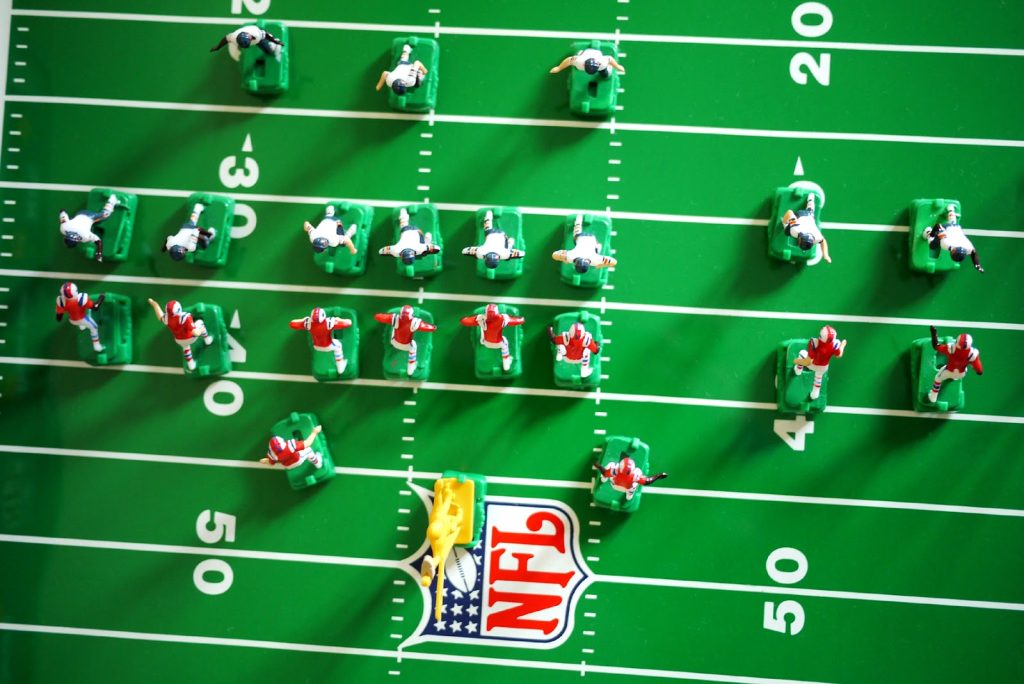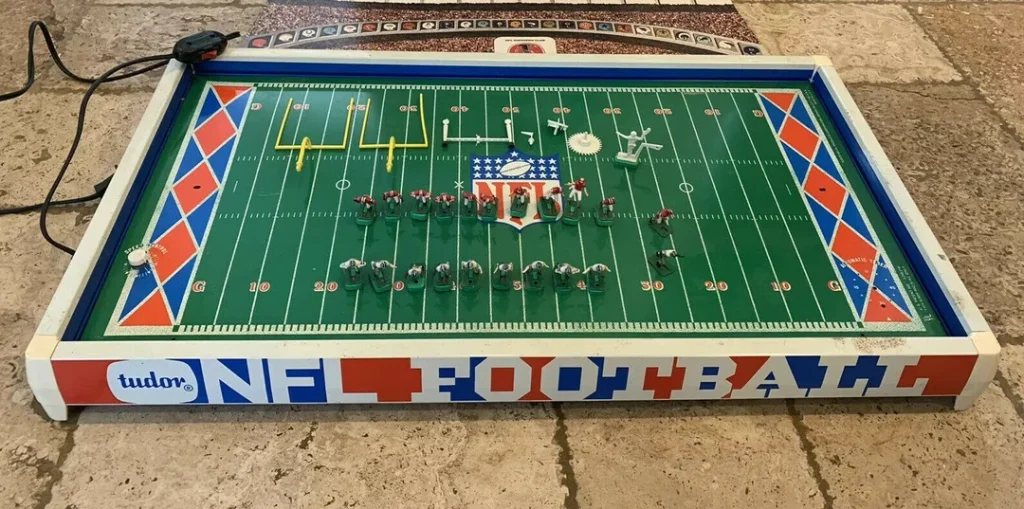Introduction
The retro electric football game stands as one of the most cherished and nostalgic tabletop experiences of the 20th century. Its buzzing field, miniature players, and unpredictable gameplay captured the imagination of countless children and adults alike. This iconic toy, which emerged in the post-war years and saw peak popularity during the 1960s and 70s, still holds a unique place in the hearts of vintage game collectors, sports fans, and toy historians. A deep dive into the origins, mechanics, cultural impact, and enduring legacy of the retro electric football game reveals not just a pastime but a testament to creativity and American innovation. Please visit this.
The Origins And Invention Of Electric Football

Electric football was first introduced in the late 1940s by Tudor Games, an American toy company founded by Norman Sas. Inspired by the surge in popularity of football and the mechanical toys of the era, Sas envisioned a game that could simulate the dynamics of American football through vibration and movement. The earliest models were crude yet innovative, consisting of a metal field mounted on a motor that created vibrations to move small plastic players. These players had pronged bases that would vibrate across the field, sometimes in random directions, mimicking the chaos and energy of a real football game. The game was an immediate success, tapping into the American fascination with football and mechanical gadgets.
How The Game Worked: Mechanics And Gameplay
At its core, the retro electric football game was simple in design yet complex in execution. Players would set up their teams in formations, and once the switch was flipped, the metal field would begin to vibrate, causing the players to jitter and shuffle in various directions. The strategic element came in adjusting the prongs on the bases of each player. Slight tweaks could make a player move in a straight line, curve left or right, or even spin. Players could control the offense and defense, running plays and attempting to maneuver a tiny foam football into the end zone. Passing the ball required a flicking motion with a spring-loaded quarterback figure, adding another layer of skill and challenge to the gameplay. Despite its lack of digital sophistication, the electric football game demanded patience, precision, and creativity, making it a favorite among young enthusiasts.
Electric Football And American Culture
The retro electric football game wasn’t just a toy; it was a cultural phenomenon. During its heyday, the game was advertised extensively on television and in magazines, especially around the holidays. Its popularity soared during the 1960s and 70s, aligning with the rise of the NFL as a dominant force in American sports. Tudor Games capitalized on this trend by licensing official NFL teams, complete with accurate team colors, logos, and even player names. Kids could recreate iconic Super Bowl matchups or invent their own fantasy leagues, imbuing the game with a level of realism and immersion that other board games lacked. Electric football became a centerpiece of many family rooms and basements, a shared experience among siblings, friends, and even parents.
The Role Of Strategy And Skill In The Game
While the game may have seemed chaotic to the untrained eye, experienced players knew there was a deep strategic component. Mastering the nuances of player movement, understanding how to form effective offensive and defensive plays, and anticipating the unpredictable nature of the vibrating field required serious skill. Tournaments and leagues began to form, with dedicated players customizing their figures, fields, and strategies. This added a layer of competitiveness and community to the game that further boosted its appeal. Some players even treated it as a form of art, painting their own teams and modifying the game board for optimal performance.
The Rise And Fall Of Electric Football’s Popularity
Like many classic toys, the retro electric football game experienced a period of decline as technology advanced. By the late 1980s and into the 1990s, the rise of video games and digital entertainment drew attention away from mechanical games. The unpredictability of the electric football players, once a source of charm and challenge, began to be seen as a flaw in comparison to the precision of video game simulations. Nevertheless, the game retained a devoted fan base. Collectors, hobbyists, and nostalgic adults continued to support and celebrate the game, keeping its legacy alive through clubs, forums, and even documentary films dedicated to its history.
Revival And Collector Culture
In recent years, there has been a resurgence of interest in retro and vintage games, and electric football is no exception. Modern versions of the game are still being produced by companies like Tudor Games, often blending classic designs with updated materials and improved mechanics. Collectors hunt for vintage sets from the 50s through the 80s, with some rare editions fetching high prices on auction sites and at toy conventions. The allure of owning a piece of football history, combined with the tactile, hands-on nature of the game, continues to attract new fans and nostalgic collectors. Restoration of old sets has become a hobby unto itself, with enthusiasts repainting figures, rewiring motors, and recreating entire stadiums in miniature detail.
Electric Football Leagues And Tournaments
One of the most fascinating aspects of the electric football revival is the emergence of organized leagues and national tournaments. These events bring together players from across the country who have honed their skills and customized their teams. Matches are played under standardized rules, with referees and detailed scoring systems. Tournaments often span several days and include everything from youth divisions to adult competitions. This competitive scene has given new life to electric football, transforming it from a simple toy into a serious sport-like activity for its most passionate fans.
Nostalgia And The Emotional Connection

For many adults today, the retro electric football game represents more than just entertainment. It symbolizes a simpler time, a connection to childhood, and the thrill of tactile play in an increasingly digital world. Parents and grandparents share the game with younger generations, creating a bridge across time and technology. The hum of the motor, the rattle of the players, and the strategic setup of each play evoke powerful memories and emotions. This nostalgia plays a crucial role in the game’s continued relevance, turning it into a beloved heirloom rather than a forgotten relic.
Comparisons With Modern Football Video Games
Comparing electric football with modern video games like Madden NFL highlights the vast differences in technology and gameplay experience. While video games offer realism, instant feedback, and online multiplayer capabilities, electric football brings physical engagement, unpredictability, and a tactile connection to the game. The two mediums appeal to different sensibilities. Electric football requires manual dexterity and patience, while video games rely on reflexes and quick decision-making. Some fans appreciate both for what they uniquely offer, enjoying electric football for its retro charm and video games for their cutting-edge immersion.
Preserving The Legacy Of Electric Football
Preserving the history of electric football has become a mission for several enthusiasts and organizations. Websites, museums, and fan clubs have documented the evolution of the game, from its early prototypes to the modern versions. Archival photos, instruction manuals, advertisements, and personal stories contribute to a rich tapestry of content that celebrates the game’s impact. Documentaries and articles have explored how electric football shaped generations of kids, teaching them about football, mechanics, and even perseverance. The game has also been featured in pop culture, appearing in movies, TV shows, and nostalgic retrospectives.
Diy Customization And The Creative Community
A notable aspect of the retro electric football scene is the vibrant DIY culture that surrounds it. Players and collectors often go beyond the original kits to customize their fields, players, and accessories. Some build elaborate stadium replicas with stands, scoreboards, and lighting. Others hand-paint team uniforms with remarkable detail, mimicking real-life NFL stars or creating entirely fictional teams. The game has inspired a community of creators who share their designs, tutorials, and gameplay strategies online. This creativity has extended the game’s appeal and allowed each set to become a unique expression of its owner’s passion.
Educational And Developmental Value

Though primarily a toy, the retro electric football game offers educational benefits as well. Children playing the game learn about physics, engineering, and basic electronics by understanding how vibration moves objects. They also gain insights into football strategy, teamwork, and problem-solving. Setting up plays and analyzing outcomes helps develop logical thinking and patience. In a world dominated by screens, electric football provides a hands-on learning opportunity that engages both mind and body. It can be a valuable tool for parents and educators looking to combine play with education.
Future Of Electric Football
Looking ahead, the future of electric football appears promising thanks to its dedicated fan base and the nostalgic resurgence of analog games. Manufacturers continue to innovate by adding better control options, quieter motors, and updated player models while retaining the essence of the original gameplay. There’s also potential for hybrid versions that blend physical play with digital enhancements, such as mobile apps for scoring, coaching tips, or augmented reality overlays. As long as people seek tactile, creative, and immersive alternatives to digital gaming, electric football is likely to endure.
Conclusion
The retro electric football game is far more than a buzzing board and tiny plastic players. It represents a fusion of innovation, sportsmanship, and play that captivated generations. From its invention in the 1940s to its golden years during the mid-20th century, and its modern revival, electric football has proven to be a timeless classic. It teaches strategy, encourages creativity, and fosters community. For those who played it as children, it’s a cherished memory. For new players, it’s a window into the history of American toys and a refreshingly analog way to enjoy the game of football. Whether you’re a collector, a hobbyist, or a curious newcomer, the retro electric football game offers a unique and enduring experience that continues to buzz with excitement.

